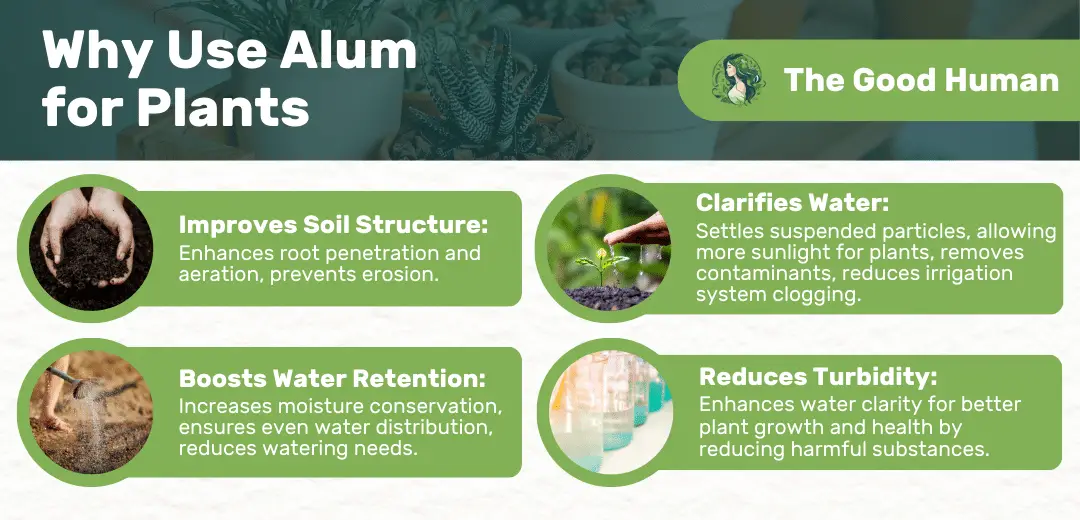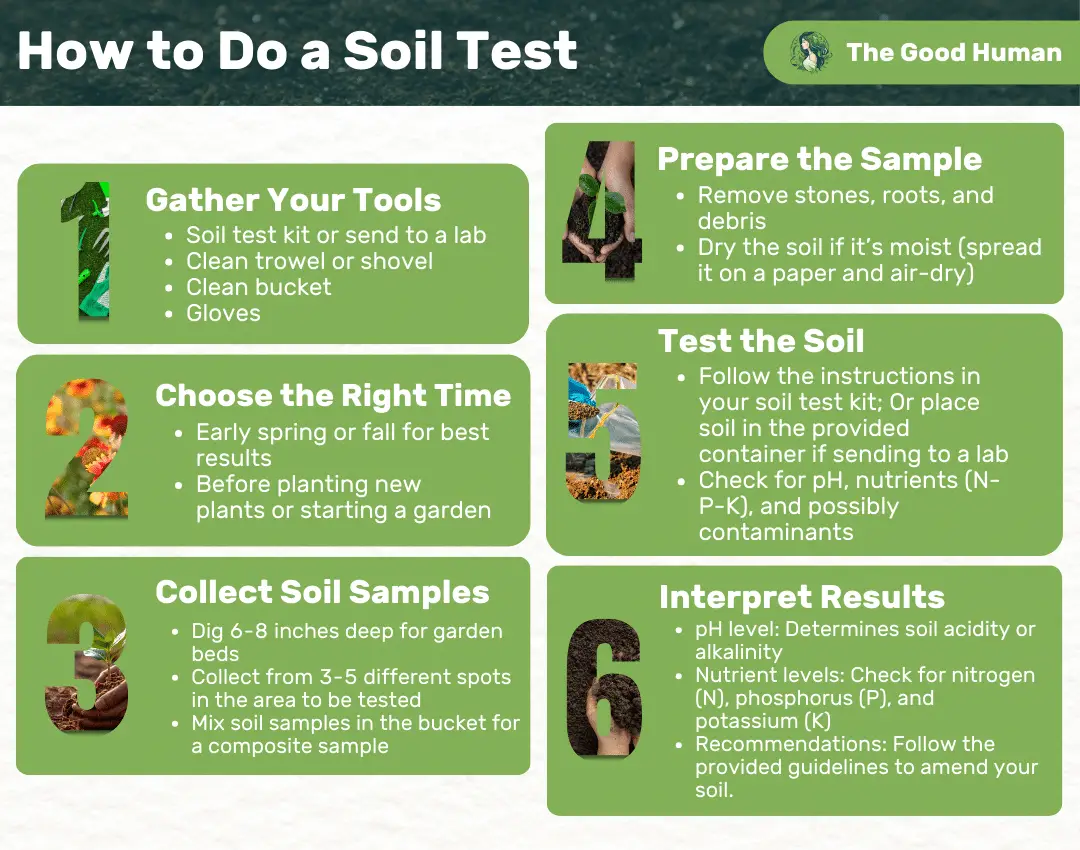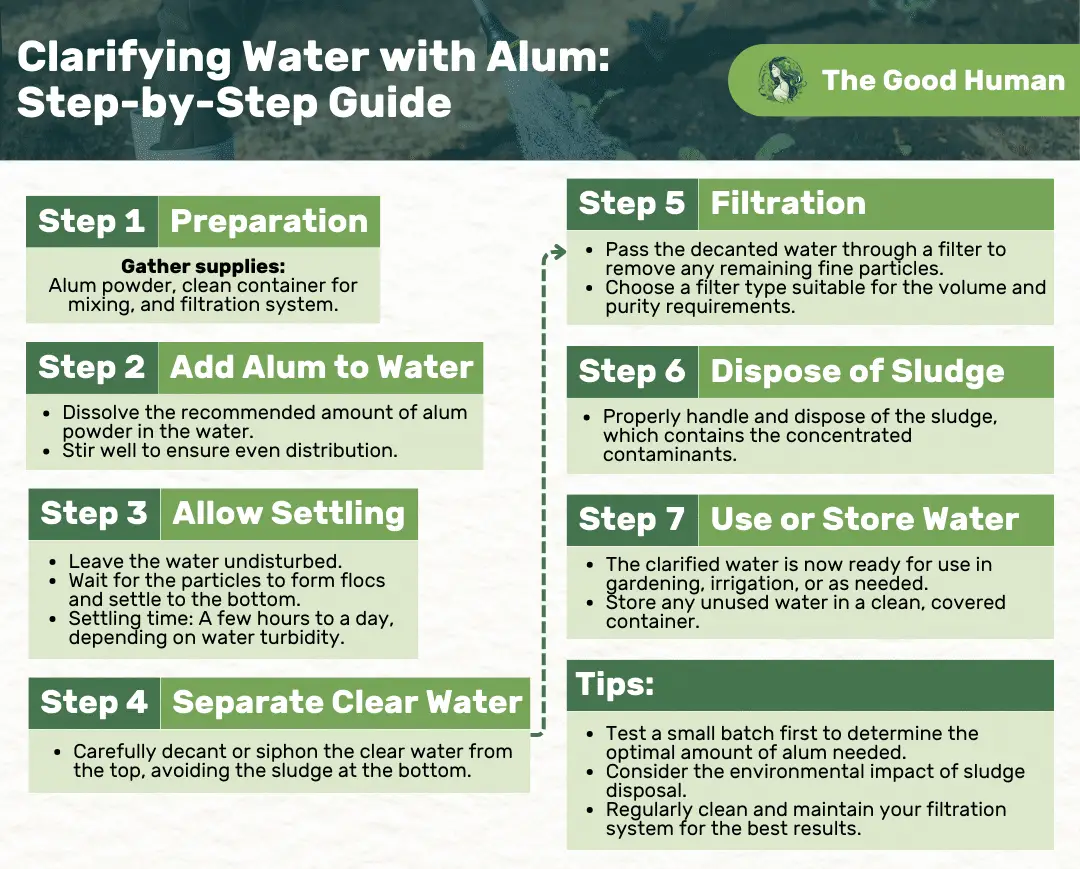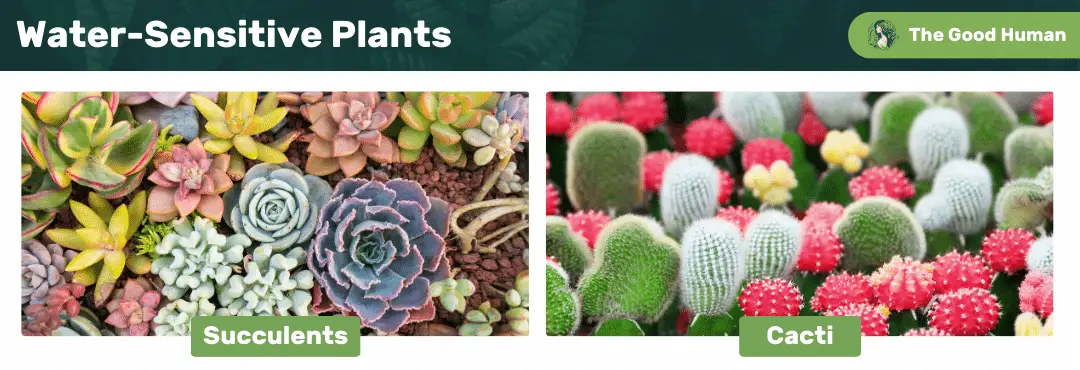Have you ever looked at your garden and wondered if there’s a secret ingredient to boost plant health and vitality? Discovering how to use alum for plants might just be the game-changer you need, offering a natural way to enhance soil and water quality for your green friends.
To use alum for plants, dilute it in water and apply to soil or use for water clarification. It improves soil structure, lowers pH for acid-loving plants, and clarifies irrigation water, enhancing plant health.
Dive into the benefits of alum for your garden, where we’ll guide you through its applications for soil amendment and water clarification. Learn how alum can transform your gardening approach, catering to the needs of acid-loving and water-sensitive plants alike.
Benefits of Using Alum for Plants
Alum, a versatile compound, has been quietly making a significant impact in the world of gardening and plant care. Its unique properties offer two major benefits: as a soil amendment and as a water clarifier, each playing a crucial role in enhancing plant health.

Alum as a Soil Amendment
In the world of soil health, alum’s role is multifaceted and deeply impactful. It primarily works wonders in two key areas: improving soil structure and enhancing water retention, both vital for robust plant growth.
Improving Soil Structure
Alum, when used in the right quantities, can greatly improve the structure of your soil. This improvement in soil structure is crucial for several reasons.
Firstly, better soil structure allows for more efficient root penetration, which is essential for strong plant growth. Roots can more easily spread through the soil, accessing the nutrients and water they need to thrive.
Secondly, improved soil structure means better aeration. This is important because roots need oxygen just as much as they need water and nutrients. With more space between soil particles, roots can breathe easier, leading to healthier and more vigorous plant growth.
In addition to facilitating root growth and aeration, alum also helps in stabilizing the soil. This stabilization is particularly beneficial in preventing soil erosion, a common problem in many gardens and agricultural settings.
Enhancing Water Retention
Alum’s ability to enhance water retention in soil is another key benefit for plants. Soils treated with alum can hold water more effectively, reducing the need for frequent watering. This is particularly beneficial during dry spells or in arid regions where water conservation is essential. By retaining moisture, alum-treated soil ensures that plants have a steady supply of water, which is critical for their growth and survival. This consistent moisture availability helps in maintaining plant turgidity and supports various physiological processes, leading to healthier and more resilient plants.
Moreover, the enhanced water retention capability of alum-treated soil is not just about holding more water. It’s also about improving the distribution of water within the soil. This means that water is more evenly spread throughout the soil, reaching deeper layers where roots can access it. This even distribution prevents issues like waterlogging and root rot, which can occur when the top layer of soil is too wet while the deeper layers remain dry.
Alum as a Water Clarifier
Transitioning to water management, alum serves an equally important role as a clarifier. According to HAB Aquatic Solutions “Alum is [also] harmless to plants. In fact, the improved water clarity after an alum application typically results in an increase of aquatic plants in the lake.”
Settling Particles in Water
When used as a water clarifier, alum’s primary function is to settle suspended particles in the water. This process begins when alum is added to water, causing fine particles to coagulate or clump together. As these particles grow larger, they become heavier and settle to the bottom, leaving the water above clearer. This settling process is crucial for several reasons.
Firstly, clear water is easier to manage and use in irrigation systems. It prevents the clogging of irrigation pipes and nozzles, which can be a significant problem when using water with high levels of suspended solids. Secondly, clearer water means less light is scattered by particles in the water, allowing more sunlight to reach aquatic plants and promote photosynthesis.
Furthermore, the process of settling particles also helps in removing potential pathogens and contaminants from the water. This is particularly important for plants that are sensitive to certain types of water-borne diseases.
Reducing Turbidity in Irrigation Water
Alongside settling particles, alum plays a key role in reducing the turbidity of irrigation water. Turbidity refers to the cloudiness or haziness of water caused by large numbers of individual particles.
High turbidity can be detrimental to plant health for several reasons. For one, turbid water can block sunlight from penetrating the water, affecting the growth of aquatic plants and disrupting the ecosystem balance. Additionally, turbid water may contain harmful substances like heavy metals or pesticides that can be detrimental to plants.
By reducing turbidity, alum-treated water becomes clearer and more conducive to plant health. This clarity is not just beneficial for aquatic plants but also for terrestrial plants that rely on this water for irrigation. Clear water ensures that plants receive the full spectrum of sunlight necessary for photosynthesis, leading to healthier and more robust growth.
Furthermore, the reduction of potentially harmful substances in the water safeguards plants against exposure to toxic elements, contributing to a safer and more sustainable gardening or agricultural practice.
Using Alum in Soil
Applying alum to soil is a straightforward process, but it requires a bit of know-how to get it right. Understanding how to prepare and incorporate alum properly is crucial for reaping its full benefits without harming your plants.
The preparation of alum for soil application starts with determining the correct dosage. This is crucial as the amount of alum needed varies based on soil type and the specific needs of your plants.
Typically, a soil test is recommended to ascertain the pH level and the existing soil condition.
Here’s how to do a soil test before using alum for plants:

Based on these results, you can calculate the right amount of alum to use. It’s often sold in a powdered form, which needs to be diluted in water. The general guideline is to use a small amount, such as a teaspoon of alum per gallon of water, but this can vary. It’s important to follow the manufacturer’s instructions or seek advice from a gardening expert to ensure the right concentration.
Once you have the right dosage, the next step is to prepare the alum solution. Dissolve the alum powder in water, stirring it until it’s completely mixed. If you’re treating a larger area, you may need to prepare the solution in a larger container or a watering can. The key is to ensure that the alum is evenly distributed in the water for uniform application. This solution should be used promptly after preparation, as its effectiveness can diminish over time.
Incorporating Alum into Soil
Incorporating alum into the soil is a delicate process that should be done carefully.
The most common method is to evenly sprinkle the alum solution over the soil surface. It’s best to do this during a time when the soil is moist but not overly wet, as this allows for better absorption.
Use a watering can or a sprayer for even distribution, ensuring that the alum solution reaches the soil without pooling in any area. It’s important to avoid over-applying the solution, as too much alum can harm the soil and plant roots.
After applying the alum solution, it’s advisable to lightly till the soil. This helps to mix the alum into the top layer of the soil, promoting even distribution and effectiveness. However, deep tilling is not necessary and can be counterproductive, as it may bring up untreated soil from below.
The key is to ensure that the alum is incorporated into the top few inches of the soil where most plant roots reside. Following the application, it’s advisable to monitor the soil and plants for any changes and to avoid immediate heavy watering, which might wash away the alum before it has had a chance to act.
When applied correctly, alum can gradually reduce the soil pH, making nutrients more available to these plants. However, it’s important to monitor the soil pH regularly, as excessive application of alum can lead to overly acidic soil, which can be detrimental to plant health.
In addition to lowering the pH, alum also affects the soil’s nutrient availability. As the soil becomes more acidic, nutrients like phosphorus, iron, and potassium become more soluble and available to plants.
This can be particularly beneficial in soils that are deficient in these nutrients. However, it’s important to strike a balance, as too much acidity can lead to the leaching of essential nutrients and potentially harm plant roots.
Using Alum in Water Clarification
Alum is not only beneficial for soil but also plays a significant role in water clarification, an important aspect of plant care. This process of clarifying water using alum helps in maintaining the health and vitality of plants in various ways.
Alum for Water Clarity
Using alum for water clarity is a traditional and effective method, especially in gardening and agriculture. It offers several benefits for plant health, each contributing to a more sustainable and productive growing environment.
Benefits for Plant Health

- Improved Photosynthesis: Clear water allows more sunlight to penetrate, which is crucial for the photosynthesis process in aquatic plants. Alum-treated water, by reducing turbidity, ensures that aquatic plants receive adequate sunlight. This increased exposure to sunlight enhances photosynthesis, leading to healthier and more robust plant growth.
- Reduced Algal Blooms: Alum clarifies water by removing excess nutrients that can cause algal blooms. Algal blooms can deplete oxygen in the water, harming aquatic life. By controlling these blooms, alum helps maintain the ecological balance in ponds and water bodies, creating a healthier environment for all plants.
- Enhanced Nutrient Uptake: Clear water can improve the efficiency of nutrient uptake in plants. When water is murky, it can hinder the ability of roots to absorb nutrients effectively. Alum, by clarifying water, ensures that plant roots have better access to the nutrients dissolved in the water.
- Prevention of Root Diseases: Murky water can be a breeding ground for pathogens that cause root diseases. By clarifying water, alum reduces the risk of these pathogens, thereby protecting plants from various root diseases. Healthy roots are essential for the overall growth and health of plants.
- Better Irrigation Efficiency: Using clear water for irrigation prevents clogging of irrigation systems, ensuring more efficient water delivery to plants. Alum-treated water, being free of suspended particles, flows more smoothly through irrigation channels. This efficiency means plants get watered evenly and consistently, which is essential for their growth.
Risks and Limitations
- Over-Application Risks: Applying too much alum can lead to water becoming too acidic. This can harm aquatic plants and alter the ecological balance of the water body. It’s crucial to use the correct dosage to avoid such negative impacts.
- Impact on Aquatic Life: While alum is effective in clarifying water, it can be harmful to fish and other aquatic organisms if not used properly. High concentrations of alum can be toxic to aquatic life, making it essential to monitor the alum levels carefully.
- Soil Acidification: When alum-treated water is used for irrigation, it can lead to soil acidification over time. This change in soil pH can affect plant growth and nutrient availability, necessitating regular soil testing and pH adjustments.
- Limited Effectiveness in Certain Conditions: Alum’s effectiveness in water clarification can be reduced in very cold or turbid conditions. It is less effective in binding certain types of particles, which can limit its usefulness in some environments.
- Potential for Aluminum Residue: There is a risk of aluminum residue settling at the bottom of water bodies after treatment with alum. This residue can potentially be harmful if it enters the plant system, especially in plants that are sensitive to aluminum.
How to Clarify Water with Alum
Clarifying water with alum involves a couple of key steps, each playing a crucial role in the effectiveness of the process.
Settling Process
The settling process begins once alum is added to the water. Alum acts as a flocculant, causing fine particles suspended in the water to clump together. As these clumps, or flocs, grow in size, they become heavier and start to settle at the bottom. This settling process is gradual and depends on factors such as the amount of alum used and the initial turbidity of the water. The key is to allow enough time for the particles to fully settle, which can vary from a few hours to a day, depending on the conditions.
Once the particles have settled, the water above becomes much clearer. This clear water is then separated from the settled sludge at the bottom. It’s important to handle the sludge properly, as it contains the contaminants removed from the water. In a garden setting, this settling process is not just about achieving clear water; it’s also about making the water more suitable and healthy for plants.
Filtration
After the settling process, the next step in water clarification using alum is filtration. Filtration involves passing the clarified water through a medium to remove any remaining particles or flocs that didn’t settle. This step is crucial to ensure that the water is as clear and clean as possible. The type of filter used can vary, ranging from simple sand filters to more complex filtration systems, depending on the scale and requirements of the project.
Filtration not only removes the residual particles but also further enhances the quality of the water for plant use. This step ensures that the water is free from any remaining turbidity and is suitable for irrigation or aquatic plants.
By removing the smallest of particles, filtration helps in preventing potential blockages in irrigation systems and ensures that the water is safe for all types of plants. Proper filtration after alum treatment can significantly improve water clarity, making it more beneficial for plant health and more efficient for gardening purposes.
Here are the steps:

Alum and Specific Plants
The application of alum can have varying effects depending on the type of plants you are growing. Understanding which plants benefit the most from alum treatments is crucial for tailoring your gardening practices to meet the specific needs of your plants.
Plants That Benefit from Alum
Certain plants respond particularly well to alum applications, thriving when it is used judiciously. These plants can be broadly categorized into acid-loving plants and water-sensitive plants, each benefiting in unique ways.
Acid-Loving Plants
Acid-loving plants, such as rhododendrons, azaleas, and blueberries, thrive in acidic soils, and alum can be instrumental in creating an ideal growing environment for them. By lowering the soil pH, alum makes it more acidic, which helps these plants absorb nutrients more effectively. Nutrients like iron, which are crucial for the growth of these plants, become more available in acidic conditions. This can lead to healthier, more vibrant foliage and an increase in flower production. Gardeners looking to enhance the growth of their acid-loving plants will find alum to be a valuable tool in adjusting soil conditions to suit these plants’ unique needs.
Additionally, the use of alum to maintain the acidity of the soil can help prevent the growth of weeds that prefer neutral to alkaline conditions. This selective advantage allows acid-loving plants to grow with less competition for nutrients and water. Regular monitoring of soil pH is necessary, however, to ensure that the acidity levels remain within an optimal range for these plants, avoiding potential issues from overly acidic conditions.

Water-Sensitive Plants
Water-sensitive plants, including various succulents and cacti, benefit from alum’s ability to clarify water and improve soil structure. By enhancing water drainage and preventing waterlogging, alum-treated soil can provide a more suitable environment for these plants, which prefer dry conditions. The improved soil structure ensures that water is distributed evenly and drains quickly, reducing the risk of root rot, a common issue in water-sensitive plants.
Moreover, alum’s role in water clarification ensures that irrigation water is free of contaminants and suspended particles, which is beneficial for plants sensitive to water quality. Clear water prevents the clogging of soil pores, maintaining the aeration and drainage that water-sensitive plants require. By using alum to treat the water, gardeners can mimic the natural, arid conditions these plants thrive in, promoting healthier growth and reducing the likelihood of disease.

Tips for Using Alum with Different Plant Types
Successfully using alum with different plant types requires understanding how to apply it effectively while minimizing risks. Here are some tips to ensure the best outcomes:
- Conduct a Soil Test Before Application: Before applying alum, conduct a soil test to determine the current pH and nutrient levels. This will help you understand how much alum is needed to achieve the desired effect without over-acidifying the soil. Tailoring the alum application to the specific needs of your soil prevents potential harm to your plants and ensures that acid-loving species benefit from the adjusted conditions.
- Apply Alum Sparingly and Gradually: Start with a lower concentration of alum and apply it gradually, observing the plants’ response over time. This cautious approach allows you to adjust the application based on the plants’ health and the soil’s changing conditions. Over-application of alum can lead to soil acidity levels that are too high for even acid-loving plants, so it’s important to increase the amount slowly and monitor the soil pH regularly.
- Use Alum-Treated Water for Water-Sensitive Plants with Caution: When using alum to clarify water for irrigation, especially for water-sensitive plants, ensure that the water’s pH and aluminum content are within safe levels for these plants. Watering lightly with alum-treated water can help avoid the accumulation of aluminum in the soil, which could potentially harm the plants. It’s also beneficial to alternate the use of alum-treated water with regular water to balance the soil conditions and avoid any negative impacts on plant health.
- Monitor Plant Health and Soil Conditions Regularly: After applying alum, keep a close eye on plant health and soil conditions. Look for signs of positive growth in acid-loving plants and improved water management in water-sensitive species. Adjusting your alum application strategy based on these observations will help optimize the benefits while minimizing any potential risks.
Safety Precautions and Environmental Considerations
Using alum in gardening requires an understanding of the safety measures and environmental impacts associated with its use. Proper handling and awareness of its effects on the environment can ensure that its benefits are maximized without causing harm.
Handling Alum Safely
When handling alum, it’s important to wear protective gloves and eyewear to prevent skin and eye irritation. Alum in powder form can be particularly irritating if inhaled, so wearing a mask during application is advisable to avoid respiratory discomfort. It’s also important to follow the recommended dosages and application methods to prevent overexposure to the compound, which could lead to adverse effects on both the handler and the soil.
Storage of alum should be in a cool, dry place, away from children and pets. As with all garden chemicals, ensuring that alum is stored properly can prevent accidental ingestion or contact, which could be harmful. Labeling the storage container with handling instructions and potential hazards can also help reduce the risk of accidents.
Environmental Impact

The use of alum has potential environmental impacts that should be considered. While alum can be beneficial for plant growth and water clarification, its overuse can lead to soil acidification and potential toxicity to aquatic life if runoff occurs. It’s crucial to apply alum in moderation and only as needed, based on soil and water tests, to minimize these risks.
Furthermore, the accumulation of aluminum compounds in the soil can potentially affect the microbial balance, which is essential for nutrient cycling and soil health. Gardeners should be mindful of the long-term impacts of alum use on their soil’s ecosystem, ensuring that they maintain a balance that supports plant health and soil vitality.
Alternatives to Alum
For those concerned about the use of alum, there are several environmentally friendly alternatives available:
- Organic Compost: Adding organic compost to the soil can improve its structure and water retention capacity, similar to alum, but without the risk of acidification. Compost introduces beneficial microorganisms that can enhance soil health and fertility over time.
- Gypsum: Gypsum is another soil amendment that can improve soil structure, particularly in clay soils, without affecting its pH. It’s an excellent alternative for gardeners looking to improve soil drainage and aeration without altering the soil’s acidity.
- Peat Moss: For acid-loving plants, peat moss can be used to lower the soil pH naturally. It also improves soil structure and water retention, making it a suitable alternative to alum for adjusting soil conditions to suit specific plant needs.
Each of these alternatives offers a sustainable approach to soil and water management in gardening, providing similar benefits to alum without the associated risks.
Common Mistakes to Avoid
Incorporating alum into your gardening practices can be highly beneficial, but it’s essential to avoid common pitfalls to ensure the health of your plants and the environment.
Overuse of Alum
The overuse of alum can lead to several problems, including soil acidification beyond the optimal pH for most plants. This can result in nutrient lock-up, where plants are unable to absorb essential nutrients from the soil, leading to poor growth and health. Additionally, excessive alum can harm beneficial soil organisms, disrupting the natural ecosystem of the garden.
Another issue with overusing alum is the potential for aluminum toxicity in plants, particularly in species that are sensitive to aluminum levels in the soil. This toxicity can inhibit root growth and reduce plant vigor, leading to stunted growth or even plant death. It’s vital to use alum sparingly and only when necessary, based on soil tests.
Incorrect Application Methods
- Applying Without Soil Testing: Using alum without conducting a soil test first can lead to incorrect application rates, either too much or too little, which can be ineffective or harmful.
- Uneven Application: Applying alum unevenly can create pockets of acidity in the soil, affecting plant growth unevenly and potentially leading to root damage in areas with concentrated alum.
- Ignoring Manufacturer’s Instructions: Not following the manufacturer’s guidelines for dilution and application can result in improper use of alum, leading to potential harm to both plants and the environment.
Avoiding these incorrect methods and following recommended practices can prevent negative outcomes and ensure that alum is used safely and effectively.
Neglecting Plant-Specific Needs
“The secret to successful gardening lies in listening to the needs of your plants and responding with care and attention.” – Carol Klein
Alum can be beneficial for many plants, but it’s important to recognize that each plant species has unique requirements. Applying alum without considering the specific needs of each plant can lead to adverse effects. For example, plants that prefer alkaline soils can suffer in the acidified soil created by alum application, leading to nutrient deficiencies and poor growth.
Moreover, failing to adjust alum application based on the plant’s life stage or health condition can also result in negative impacts. Young plants or those already stressed by environmental conditions may be more sensitive to changes in soil chemistry caused by alum. Tailoring the use of alum to the specific needs and conditions of each plant is crucial for promoting healthy growth and avoiding harm.
Tips and Best Practices
To make the most out of using alum in gardening, it’s essential to adopt certain tips and best practices that ensure its benefits are fully realized without causing unintended harm.
Maximizing Alum’s Benefits

To maximize the benefits of alum, start with a soil test to determine the existing pH level and nutrient status. This information will guide the appropriate amount of alum to use, ensuring that you enhance soil conditions without over-acidifying. Incorporating alum into your gardening routine should be done gradually, monitoring the soil’s response and adjusting applications as needed to achieve the desired effect.
Additionally, combining alum with organic gardening practices, such as mulching and the use of compost, can enhance soil health and plant growth further. These practices work synergistically with alum to improve soil structure, water retention, and nutrient availability, creating a more vibrant and productive garden.
Monitoring Plant Health
Regular monitoring of plant health is crucial when using alum. Observing plant growth, leaf color, and overall vigor can provide early indications of whether the soil conditions are supporting plant health. If signs of distress or poor growth are observed, re-evaluate the use of alum and consider soil re-testing to adjust the application accordingly.
It’s also important to be mindful of the environmental conditions, as changes in weather, water availability, and other factors can influence how plants respond to alum-treated soil. Being responsive to these conditions and adjusting care practices can help ensure that plants remain healthy and thrive.
Seasonal Considerations
The effectiveness of alum applications can vary with the seasons, affecting how plants respond. In spring, when plant growth is vigorous, alum can help ensure that acid-loving plants have access to the nutrients they need. However, during the hot, dry summer months, it’s important to be cautious with alum applications, as plants are more susceptible to stress, and soil moisture levels can fluctuate widely.
In autumn, applying alum can help prepare plants for the winter by adjusting soil pH to optimal levels, but it’s crucial to avoid heavy applications that could impact the soil’s ability to buffer against rapid pH changes. Winter applications should generally be avoided, as plant growth is minimal, and the risk of over-accumulation in the soil is higher.
Final Thoughts
Incorporating alum into your gardening practices can offer numerous benefits, from improving soil structure and acidity to clarifying irrigation water. However, it’s essential to approach its use with caution, understanding the specific needs of your plants and the environmental implications. By adhering to safety precautions, considering environmental impacts, and avoiding common mistakes, you can make the most of alum’s advantages. Whether you’re aiming to boost the growth of acid-loving plants or improve water quality for irrigation, a thoughtful and informed approach to using alum can lead to a healthier, more vibrant garden.







